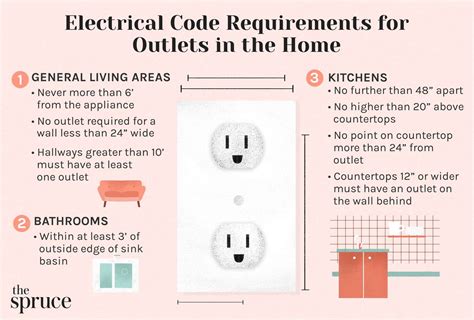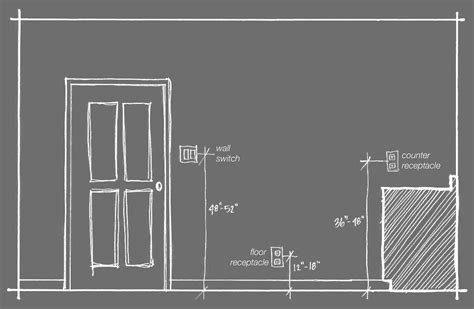electrical receptacle box height The NEC minimum height for an outlet box above the floor is 12 inches (30.5 cm). However, many electricians recommend installing outlets at an altitude of 18 inches (45.7 cm) to make them easier to reach.
CNC turning is a machining process used in manufacturing to produce cylindrical parts.
0 · residential electrical outlet height
1 · receptacle mount height
2 · receptacle box mount height
3 · kitchen countertop receptacle height
4 · how high to mount kitchen receptacles
5 · how high to mount box outlet
6 · height of electrical outlet box
7 · countertop outlet box height
$64.95
Use this guide to learn the standard heights for outlets and light switches, the best ways to measure them, and what codes you may need to follow. The standard height for wall outlet boxes is about 12 inches from the top of the floor covering to the bottom of the .In kitchens, electrical outlets should be placed no farther than 48 inches apart, .Requirements for electrical receptacle (outlet or wall plug) spacing, height, and clearances in buildings. Details about spacing, height, and clearance for receptacles are provided in this . The standard height for electrical outlets in residential homes is about 12 inches from the top of the floor covering to the bottom of the receptacle box, or 16 inches to the top of the box. However, local building codes and .
The National Electrical Code (NEC) doesn’t specify a standard light switch height, but many local electricians will go with a height of 48 inches above the floor (measured from the floor to the bottom of the switch box). The NEC minimum height for an outlet box above the floor is 12 inches (30.5 cm). However, many electricians recommend installing outlets at an altitude of 18 inches (45.7 cm) to make them easier to reach.
In kitchens, electrical outlets should be placed no farther than 48 inches apart, so that no point on the countertop is more than 24 inches away from a receptacle. Any countertop 12 inches wide or more should have an outlet on . Setting electrical outlets and wall switches and standard, uniform heights is important both for ease of installation, and for the convenience of users. Installing multiple boxes along a wall is much faster and easier when each box .Electrical Outlets by the Numbers Building codes dictate specific height and spacing measurements for receptacles and switches. Learn what the most common dimensions are and why. This article series gives the requirements for electrical receptacle (outlet or wall plug) spacing, height, and clearances in buildings, and how to choose, locate, and wire an electrical receptacle in a home.
Use this guide to learn the standard heights for outlets and light switches, the best ways to measure them, and what codes you may need to follow. The standard height for wall outlet boxes is about 12 inches from the top of the floor covering to the bottom of the receptacle box (or 16 inches to the top of the box). Receptacles are needed in every room of a home such that no point on a wall is over 6′ from an outlet. This means that you need an outlet within 6′ of a doorway or fireplace. A long wall, however, may have up to 12′ between outlets.Requirements for electrical receptacle (outlet or wall plug) spacing, height, and clearances in buildings. Details about spacing, height, and clearance for receptacles are provided in this article. - How to wire and install an electrical outlet The standard height for electrical outlets in residential homes is about 12 inches from the top of the floor covering to the bottom of the receptacle box, or 16 inches to the top of the box. However, local building codes and individual laws may have specific requirements.
The National Electrical Code (NEC) doesn’t specify a standard light switch height, but many local electricians will go with a height of 48 inches above the floor (measured from the floor to the bottom of the switch box).
residential electrical outlet height

receptacle mount height
The NEC minimum height for an outlet box above the floor is 12 inches (30.5 cm). However, many electricians recommend installing outlets at an altitude of 18 inches (45.7 cm) to make them easier to reach. In kitchens, electrical outlets should be placed no farther than 48 inches apart, so that no point on the countertop is more than 24 inches away from a receptacle. Any countertop 12 inches wide or more should have an outlet on the wall behind the countertop.

Setting electrical outlets and wall switches and standard, uniform heights is important both for ease of installation, and for the convenience of users. Installing multiple boxes along a wall is much faster and easier when each box is the same height.
Electrical Outlets by the Numbers Building codes dictate specific height and spacing measurements for receptacles and switches. Learn what the most common dimensions are and why. This article series gives the requirements for electrical receptacle (outlet or wall plug) spacing, height, and clearances in buildings, and how to choose, locate, and wire an electrical receptacle in a home. Use this guide to learn the standard heights for outlets and light switches, the best ways to measure them, and what codes you may need to follow. The standard height for wall outlet boxes is about 12 inches from the top of the floor covering to the bottom of the receptacle box (or 16 inches to the top of the box).
Receptacles are needed in every room of a home such that no point on a wall is over 6′ from an outlet. This means that you need an outlet within 6′ of a doorway or fireplace. A long wall, however, may have up to 12′ between outlets.Requirements for electrical receptacle (outlet or wall plug) spacing, height, and clearances in buildings. Details about spacing, height, and clearance for receptacles are provided in this article. - How to wire and install an electrical outlet The standard height for electrical outlets in residential homes is about 12 inches from the top of the floor covering to the bottom of the receptacle box, or 16 inches to the top of the box. However, local building codes and individual laws may have specific requirements.
The National Electrical Code (NEC) doesn’t specify a standard light switch height, but many local electricians will go with a height of 48 inches above the floor (measured from the floor to the bottom of the switch box). The NEC minimum height for an outlet box above the floor is 12 inches (30.5 cm). However, many electricians recommend installing outlets at an altitude of 18 inches (45.7 cm) to make them easier to reach. In kitchens, electrical outlets should be placed no farther than 48 inches apart, so that no point on the countertop is more than 24 inches away from a receptacle. Any countertop 12 inches wide or more should have an outlet on the wall behind the countertop.
Setting electrical outlets and wall switches and standard, uniform heights is important both for ease of installation, and for the convenience of users. Installing multiple boxes along a wall is much faster and easier when each box is the same height.Electrical Outlets by the Numbers Building codes dictate specific height and spacing measurements for receptacles and switches. Learn what the most common dimensions are and why.

receptacle box mount height

insulated metal roofing sheets price
You need approved junction boxes for the receptacles. Low voltage and 120V AC cannot be in the same box without an approved divider. You cannot run an extension cord in the wall.
electrical receptacle box height|height of electrical outlet box